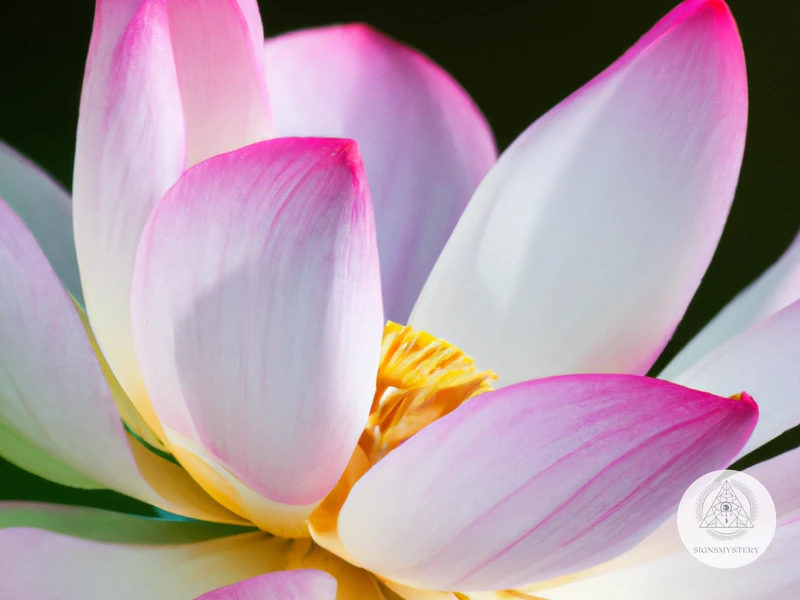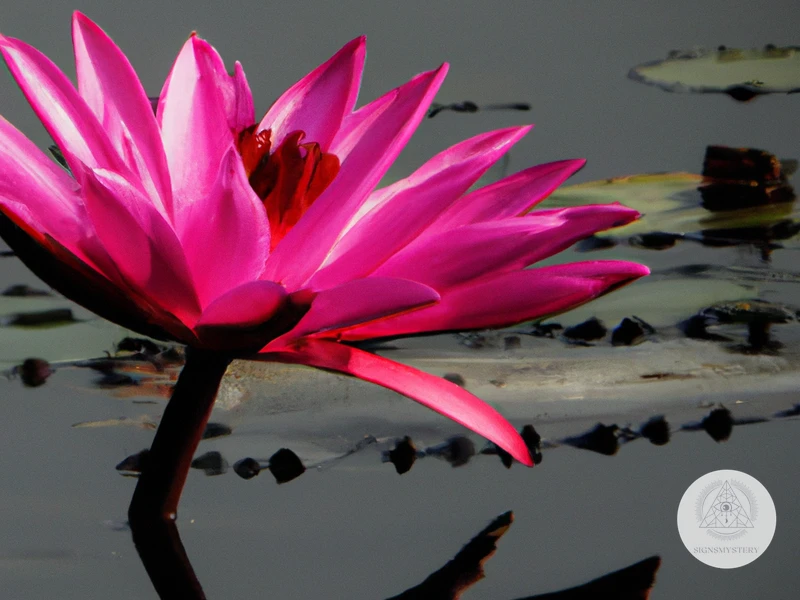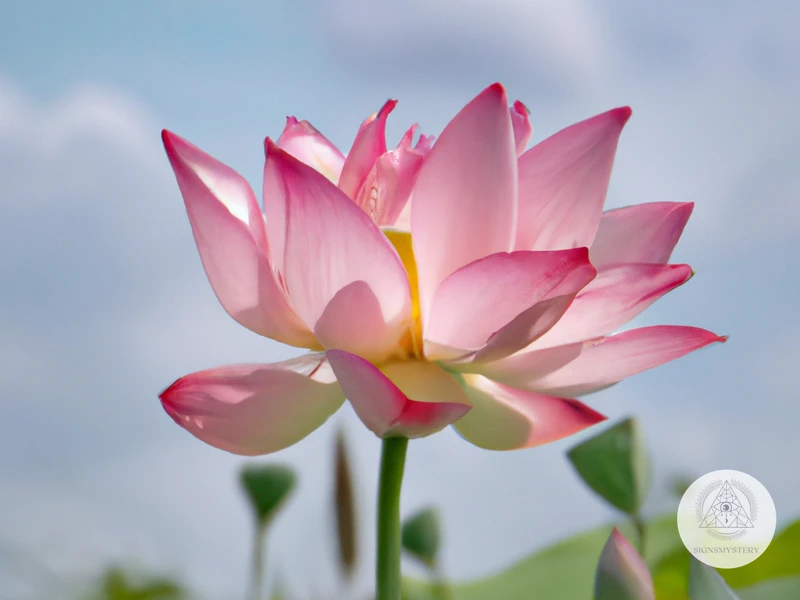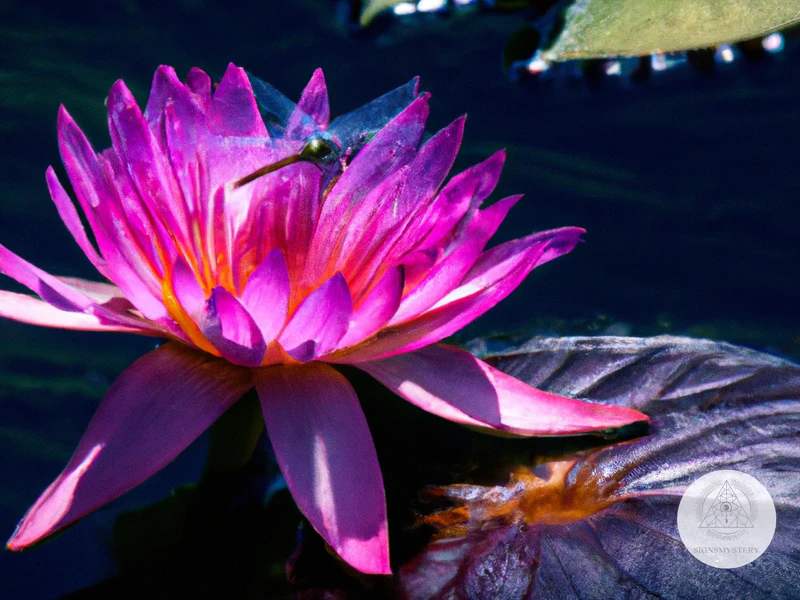The lotus flower holds a significant place in Hinduism due to its powerful symbolism. This exquisite flower is regarded as both auspicious and divine, embodying various philosophical and religious ideals. Its roots might be lost in history, but its association with Hindu mythology and its use as a religious symbol continue to influence Indian culture. The lotus is not merely a beautiful flower but represents a profound spiritual concept that has held a special place in the hearts and minds of Hindus for centuries. In this article, we will delve deeper into the historical roots and religious interpretations of the lotus flower in Hinduism, exploring its regional differences, symbolism in art and architecture, and its significance in various festivals.
Historical Significance

The use of lotus in Hinduism dates back to ancient times. The flower has been mentioned in various ancient Hindu scriptures like the Vedas, Puranas, and Upanishads. The ancient Hindus observed the lotus throughout their natural surroundings. They witnessed that the lotus flower emerged pure and clean despite growing in the mud and murky water. They embraced this idea and integrated it into their religion and culture by using the lotus as a symbol to represent various aspects of life, spirituality, and enlightenment.
The lotus is known to have originated in India and Egypt and has since become a symbol of many cultures and religions worldwide. The ancient Egyptians regarded the lotus as a sacred flower that represented rebirth and creation. The ancient Hindus, on the other hand, associated the lotus with spiritual awakening and enlightenment.
In Hindu mythology, the lotus is believed to be the seat of gods and goddesses, including Brahma, Lakshmi, and Saraswati. According to Hindu mythology, the creation of the universe began when Brahma emerged from a lotus that grew from the navel of Lord Vishnu. The lotus flower is also believed to represent the goddess Padma, who is the Hindu goddess of beauty and fertility. She is often depicted sitting on the lotus flower, representing the idea of beauty and purity arising from the midst of chaos.
The lotus is also associated with Lord Ganesha, who is a popular Hindu deity. He is often depicted holding a trishula (trident) and sitting on a lotus flower. In some depictions, the lotus is shown growing from Ganesha’s stomach, representing his divine nature.
The lotus is also a symbol of Mother Earth and her infinite beauty and abundance. It is often referred to as the “earth’s womb” because it has its roots in the soil, its stem in the water, and its petals in the air.
The lotus has significant historical importance in Hinduism. With its emergence from the mud and ability to remain pure and clean in murky water, the lotus has become a symbol of spirituality, purity, and enlightenment throughout Hindu mythology and culture.
Ancient Roots
The lotus flower has been a significant symbol in Hinduism for thousands of years. Its roots lie in ancient Hindu texts and mythology, where the lotus is frequently mentioned as a symbol of purity and divinity. The ancient Hindu scriptures, the Vedas, mention the lotus as a symbol of spiritual enlightenment. The lotus flower is also mentioned in texts such as the Puranas and the Bhagavad Gita in the context of teachings about karma and rebirth.
In Hinduism, the lotus flower is thought to represent the cycle of creation and rebirth. The lotus flower grows in muddy waters, but its petals remain clean and pure. This is seen as a metaphor for the human soul, which must navigate the muddy waters of earthly life in order to attain spiritual enlightenment and purity of the soul. The lotus is also associated with the Hindu gods Brahma, Vishnu, and Shiva, who are often depicted seated on or holding lotus flowers.
According to some scholars, the lotus has its roots in pre-Vedic Indian religions and was later incorporated into Hinduism. The lotus is also a symbol in ancient Indian art and architecture, with depictions of the flower found in ruins dating back to the Indus Valley Civilization.
The ancient roots of the lotus in Hinduism are a testament to the significance and importance of the flower as a spiritual symbol in the religion. Its enduring symbolism continues to captivate and inspire people around the world today.
The Lotus in Hindu Mythology
In Hindu mythology, the lotus flower holds a very significant place. It is believed to be the flower that was associated with the creator of the universe, Lord Brahma. The story goes that Lord Brahma was in search of a suitable foundation for creating the universe. He found nothing, so he meditated. During his meditation, a lotus emerged from the navel of Lord Vishnu, a deity who was reclining on a serpent. Inside the lotus was Lord Brahma who then commenced the creation of the universe.
The lotus also has a connection to several other Hindu deities. The goddess of wealth and prosperity, Lakshmi, is depicted standing on a lotus flower. The god of love, Kamadeva, is also associated with the lotus, as is the god of creation, Brahma.
In Hindu mythology, the lotus is also connected to the concept of reincarnation. The belief in reincarnation states that after death, the soul is reborn into another body. The lotus is believed to represent this process of rebirth, as it blooms in muddy waters and emerges into the air, representing new life.
The lotus in Hindu mythology represents purity, beauty, divinity, fertility, wealth, and knowledge. It is a symbol of creation and rebirth, and is highly regarded in Hindu culture.
Religious Interpretations
The Lotus flower carries great religious significance in Hinduism. It has been interpreted in various ways by different schools of thought in Hinduism. The following are some of the most significant religious interpretations of the lotus flower in Hinduism.
In Hindu mythology, the creator god Brahma is depicted as rising from the lotus flower that emerges from the navel of Lord Vishnu, the preserver of the universe. This portrayal signifies the birth of creation and suggests that the lotus flower is associated with the creative and regenerative powers of the cosmos. The lotus is believed to signify life, fertility, purity, and cosmic renewal.
Another religious interpretation of the Lotus flower is based on its importance in spiritual practices. The lotus symbolizes the potential of the human soul for spiritual growth and transformation. Just as the lotus grows from muddy waters towards the light and emerges in its full glory, the human soul can also transcend the material world and attain spiritual enlightenment. This association of the lotus with spiritual growth and enlightenment is depicted in many Hindu artwork and scriptures.
In Hinduism, the lotus flower is also associated with the act of devotion. Devotees offer lotus flowers to the Gods in temples, during religious ceremonies, and as part of daily prayers. The act of offering a flower, especially the lotus, is considered auspicious and significant in Hindu culture. The lotus flower thus symbolizes the devotion and surrender of the devotee to the divine.
The symbolism of the lotus flower in Hinduism is multifaceted and rich. Its various interpretations signify the creative and regenerative potential of the universe, spiritual enlightenment, and devotion. The Lotus flower’s significance in Hinduism is also visible in its depiction in arts, architecture, and festivals.
The Lotus as a Symbol of Creation and Rebirth
The lotus flower is widely regarded as a symbol of creation and rebirth in Hinduism. Its ability to rise untainted from muddy waters is seen as a representation of new beginnings, making it a significant spiritual emblem in Hindu mythology.
In Hindu creation stories, it is believed that the universe was born out of chaos and that Lord Brahma chose the lotus flower as the foundation for the creation of the world. According to legend, Lord Brahma was birthed from the petals of a lotus flower which grew from Lord Vishnu’s navel. The unfolding petals of the lotus flower symbolize the expansion of the universe from its center, reflecting the idea of continuous creation and expansion.
Similarly, the lotus flower is also a symbol of rebirth. As the flower blooms at dawn and withers away at dusk, it represents the cycle of life, death, and rebirth. This cycle of rebirth is not only associated with physical reincarnation but also the spiritual growth of an individual. In Hinduism, it is believed that with each rebirth, the soul evolves closer to perfection and becoming one with the divine.
The lotus flower’s connection to creation and rebirth is also reflected in the Hindu concept of chakras, or “energy centers,” in the body. The seventh chakra, or Sahasrara, is located at the crown of the head, and is said to be represented by a lotus flower with a thousand petals. This chakra is associated with spiritual enlightenment and ultimate transcendence, and the lotus flower serves as a powerful symbol of this spiritual journey.
The symbolism of the lotus flower as a representation of creation and rebirth is also reflected in Hindu religious practices, where it is often used in offerings, prayers, and purification rituals. The lotus flower‘s pure beauty and association with rebirth make it a powerful symbol of hope, purity, and spiritual growth for Hindus.
The lotus flower holds great significance in Hinduism as a symbol of creation and rebirth. Its connection to the expansion of the universe, the cycle of life, death, and rebirth, and spiritual growth make it a powerful emblem of Hindu spirituality.
The Lotus and Spiritual Enlightenment
The Lotus flower is not only a symbol of creation and devotion, but also of spiritual enlightenment in Hinduism. Because of its unique growth and blooming process, the Lotus has been associated with the idea of enlightenment, or reaching a higher level of consciousness beyond the material world.
According to Hindu philosophy, spiritual enlightenment can be achieved through the practice of yoga, meditation, and self-realization. The Lotus flower has been used as a visual aid to help focus the mind during meditation, as it is believed to represent the journey of the soul from darkness to light, and from ignorance to knowledge.
In Hindu artwork and literature, the Lotus is often depicted as a symbol of the journey to spiritual enlightenment. For example, the famous Hindu scripture, Bhagavad Gita, describes the journey of the soul as a Lotus growing out of the muddy waters of the material world and blooming into the pure and eternal light of spiritual consciousness.
In addition to its visual symbolism, the Lotus has also been associated with certain spiritual practices in Hinduism. For instance, the Lotus pose, or Padmasana, is a seated yoga asana that is believed to help awaken spiritual energy and promote inner peace.
The Lotus flower holds a special place in Hinduism as a symbol of spiritual enlightenment and the journey to higher consciousness. Its unique growth and visual beauty make it an inspiring and powerful symbol for those seeking to deepen their spiritual practice and achieve a greater understanding of the universe and their place in it.
The Lotus as a Symbol of Devotion
In Hinduism, the lotus flower is also a symbol of devotion. It represents the purity of devotion and the surrender one has towards their faith and their god. The way a lotus flower rises up from the mud and blooms into a beautiful flower is a representation of how one can rise above their impurities and devote themselves to their god.
The use of lotus flowers during worship and prayer is common in Hinduism. During puja, Hindus offer lotus flowers to their gods and goddesses which is a symbol of their devotion. The lotus flower is believed to be the favorite flower of Lord Vishnu and Goddess Lakshmi, and it is often used in their worship.
In Hindu literature, the lotus symbolizes the four divine attributes of the Supreme Reality, namely, truth, beauty, goodness, and bliss. The opening of the lotus petals represents the expansion of the soul and the unfolding of one’s spiritual consciousness.
In Hinduism, the lotus flower is associated with the heart chakra, known as the Anahata chakra. The heart chakra represents unconditional love, compassion, and purity of heart. The lotus flower is a symbol of the awakening of the heart chakra and the opening of the heart to love, devotion, and compassion.
The lotus flower serves as a reminder of the importance of devotion, surrender, and purity in Hinduism. Through its symbolism in religious and spiritual practices, it encourages individuals to rise above their impurities and devote themselves to their faith and their god.
Regional Differences

The symbolism of the lotus flower varies in different regions of India. Let’s take a look at the differences:
In North India, the lotus is often associated with Lakshmi, the goddess of wealth, fortune, and prosperity. Lakshmi is usually depicted sitting on a lotus throne and holding lotus flowers in her hands. The lotus is also a symbol of purity and divinity in this region.
In South India, the lotus is often associated with Brahma, the creator god of the Hindu trinity. Brahma is believed to have emerged from a lotus that grew from the navel of Lord Vishnu. The lotus flower is also associated with Kamakshi, the goddess of love, fertility, and desire. Kamakshi is often depicted holding a lotus in her hand.
It is interesting to note that the lotus is also an important symbol in Buddhism and Jainism, which are other major religions in India. In these religions, the lotus is often used as a symbol of spiritual purity, detachment, and enlightenment.
To further understand how regional differences impacted the symbolism of the lotus, let’s consider some interesting facts about the use of lotus in Indian art and architecture.
Lotus Symbolism in North India
In North India, the lotus flower symbolizes purity and divinity. It is believed that the goddess of wealth and prosperity, Lakshmi, sits on a fully bloomed pink lotus. The lotus is also associated with good fortune and wealth.
In Hindu mythology, the god Brahma, the creator, is often depicted sitting on a lotus flower. This signifies that the lotus is the source of all creation. The lotus flower is believed to represent the womb of the universe, which gave birth to the four main Hindu gods: Brahma, Vishnu, Shiva, and Mahesh.
The lotus flower is also an important symbol in yoga practice. The lotus pose, or Padmasana, is a common meditation posture that aims to purify the mind and body. Practitioners believe that sitting in this pose helps to calm the mind and access inner peace, just like the serene and pure lotus flower.
In North India, the lotus flower is symbolic of the chakras, or energy centers, in the body. The lotus represents the Sahasrara chakra, which is located at the crown of the head and is associated with spiritual enlightenment and the merging of the individual self with the divine.
The lotus flower holds a prominent place in North Indian culture and religion. Its symbolism is varied and far-reaching, encompassing wealth, purity, creation, and spiritual enlightenment. As such, the lotus remains an integral part of Hindu culture and beliefs to this day.
Lotus Symbolism in South India
In South India, the lotus flower also holds great cultural and religious significance. The flower is prominently featured in the region’s art, literature, and mythology. The lotus is often depicted in South Indian temple architecture, where it serves as a symbol of purity, divinity, and fertility.
One of the most popular deities in South India, Goddess Lakshmi, is often depicted sitting on a fully-bloomed lotus, symbolizing her purity and divine beauty. In fact, the goddess is known as Padmavati, meaning “she who sits on a lotus.” The lotus flower is also a prominent symbol in the traditional dance forms of South India, such as Bharatanatyam, where dancers often use hand gestures to mimic the opening and closing of the lotus flower.
The lotus is also associated with Lord Vishnu, who is one of the most revered deities in South India. In Hindu mythology, Lord Vishnu is often depicted floating on a vast ocean, resting on the many-headed serpent Ananta. Lord Vishnu is sometimes shown holding a lotus in one of his hands, which serves as a symbol of his divine energy and earthly detachment.
In South India, the lotus flower is also associated with the concept of Kundalini, which is believed to be the spiritual energy that resides at the base of the human spine. According to Hindu tradition, when this energy is awakened, it rises up through the chakras, or energy centers, until it reaches the Crown Chakra, located at the top of the head. The shape of the lotus flower is said to represent the seven chakras, with the fully-bloomed lotus at the Crown Chakra symbolizing spiritual enlightenment.
The lotus flower holds a deep spiritual and cultural significance in South India and is an important symbol of divinity, purity, and enlightenment. Its association with revered deities, traditional dances, and spiritual energy makes it a central element of South Indian culture and tradition.
Lotus in Art and Architecture
The lotus flower has, over time, become a revered symbol in Hindu art and architecture. The flower’s charm and beauty are often represented in various art forms, such as paintings, sculptures, and embroidery, among others. The lotus flower in Hindu art is one of the most prominent symbols and is often associated with purity, divinity, beauty, and fertility.
The architecture of Hindu temples often depicts the lotus symbol in many different ways. One prominent example is the use of the lotus as a base for the various temple structures, including pillars and the foundation. The lotus flower’s shape takes a prominent position in architecture, serving as the foundation for the temple’s grand entrance. It’s a common practice to have a lotus pond or pool within the temple’s premises. Here, the lotus flowers bloom, symbolizing purity and
Subscribe to Our Newsletter
Sign up to receive the latest news and updates.
In the architecture of Hindu temples, the lotus is not only symbolic but also practical. The lotus shape is often used as a base material for the temple structures, like pillars and roofs, due to its stability and durability. The use of the lotus in temple architecture showcases the significance of the flower in Hindu culture.
Indian paintings and sculptures often depict the lotus flower as a prominent symbol. The intricate details of the flower are masterfully captured in the paintings, which often showcase the lotus in various stages of its growth. The lotus is also shown in paintings as a seat for deities, in which they sit, often holding a lotus flower in their hand.
Sculptures are also a popular way of representing the lotus flower in Indian art. They showcase the symbolic significance of the lotus in Hinduism. Some sculptures depict different deities holding a lotus flower, while others depict beautiful lotus ponds.
The lotus flower’s symbolism plays an integral role in the art and architecture of Hinduism. Its use showcases the significance the flower has in Hinduism, and serves as a visual reminder of the culture’s rich history and traditions.
Lotus in Hindu Temple Architecture
The lotus flower is a recurring motif in Hindu temple architecture, which beautifully showcases the flower’s significance in Hinduism. The architecture of Hindu temples typically incorporates lotus-shaped structures in different forms, including the lotus dome and the lotus finial.
The lotus dome is a unique architectural feature of Hindu temples, which includes concentric layers of petals symmetrically arranged in a circular shape. This dome structure is inspired by the idea of a blooming lotus, which symbolizes the enlightened soul and its journey towards spiritual awakening. In some temples, the lotus dome is adorned with intricate carvings and sculptures, depicting tales from Hindu mythology.
Similarly, the lotus finial or the Kalash is a crowning ornament in the architecture of many Hindu temples. It is usually placed at the top of the temple’s spire and is designed to resemble a blooming lotus bud. It signifies spiritual purity and knowledge and represents the highest attainment of human consciousness.
Apart from the dome and finial, the lotus flower is also depicted in other decorative elements of temple architecture. For instance, the pillars of Hindu temples are often adorned with lotus motifs, and the padma or the lotus throne, is considered an auspicious seat for the deities.
The lotus has a significant presence in Hindu temple architecture, symbolizing purity, divinity, and spiritual awakening. The intricate lotus-shaped structures and motifs in Hindu temples resonate with the deep-rooted symbolism of the flower in Hinduism and are a visual representation of the religion’s core principles.
Lotus in Indian Paintings and Sculptures
The importance of the lotus in Hinduism is not limited to religious interpretations but is also evident in Indian art and architecture. The delicate beauty of the flower has made it a popular motif in Indian paintings and sculptures.
Indian artists have used lotus flowers in their paintings to represent purity, enlightenment, and spiritual awakening. They are usually depicted alongside a figure of a deity or a spiritual leader. Some famous examples of lotus paintings are Raja Ravi Varma’s ‘Lotus and Swan’ and Abanindranath Tagore’s ‘Lotus Pond’. These paintings showcase the intricate beauty of the flower and its spiritual significance.

In Indian sculptures, the lotus is a popular motif and is often used as a base for statues of deities. It is the base on which sits the god Brahma, whose four heads represent the four Vedas, the ancient Hindu scriptures. The goddess Lakshmi, who is associated with wealth and prosperity, is often depicted sitting on a lotus flower. The lotus is also used in the sculptures of Lord Vishnu and his incarnations. Interestingly, the Buddha is often depicted seated on a lotus, which serves as a symbol of purity, detachment and enlightenment.
Examples of Lotus Motifs in Indian Sculptures
- The Lotus Throne of Buddha in Sanchi Stupa
- The Lotus Mahal in Hampi, Karnataka
- The Lotus Pools in the City Palace, Jaipur
The beauty and symbolic significance of the lotus have made it an appealing motif in Indian art for centuries. It serves as a reminder of the importance of purity, enlightenment and spiritual awakening in Hinduism. Its use in paintings, sculptures, and architecture makes it an integral part of India’s cultural heritage.
Read more about historical symbols in Hinduism here.
Lotus Festivals

Lotus festivals hold immense cultural and religious significance in Hinduism. They are celebrated as a means to offer adoration to the Lotus, the divine flower that is closely associated with the gods and goddesses of Hinduism. The festivals provide a platform for believers to offer their devotion and gratitude to the divine. Lotus festivals offer a unique opportunity for Hindus to reflect on the symbolism and importance of the Lotus in Hindu culture.
There are many festivals in different regions across India that celebrate the Lotus flower. The most popular among them are the Lotus festivals that are held in the east of India, particularly in West Bengal and Odisha states.
The Lotus festival celebrated in the West Bengal state of India is known as ‘Kamalakshya Das Jayanti’ and is dedicated to Lord Vishnu and the Lotus flower. The festival is celebrated with great enthusiasm and involves the offering of Lotus flowers to the deity.
Similarly, the Lotus festival celebrated in Odisha is known as ‘Kakatpur Mangala Temple Lotus Festival’. The festival is celebrated at the famous Kakatpur Mangala Temple which is dedicated to the goddess Mangala and is located near Puri. During the festival, thousands of devotees gather to offer Lotus flowers to the goddess and seek her blessings.
The ‘Lotus Mahotsav’ is another popular festival that is celebrated in the state of Maharashtra. The festival is dedicated to the Lotus as a symbol of purity, knowledge, and devotion.
Lotus festivals are an important part of Hindu culture and provide believers with a chance to offer their devotion to the divine. They offer a great opportunity for people to come together and celebrate the symbolism and significance of the Lotus flower in Hinduism.
Significance of Lotus Festivals in Hinduism
Lotus Festivals are an integral part of Hindu culture and are celebrated all over India with great devotion and enthusiasm. These festivals hold immense significance in Hinduism and are celebrated throughout the year. The festival is called “Pushpotsavam” in Sanskrit, which means the festival of flowers. The festival is primarily associated with the worship of Lord Vishnu, Lord Brahma, and Lord Shiva, all of whom have strong connections with the lotus flower.
The lotus, being a symbol of purity and divinity, holds immense importance in Hindu festivals. The festivals aim to highlight the beauty and purity of the lotus flower and its association with the divine. The festivals also represent rebirth and the creation of new life, as the lotus flower grows in muddy waters and yet emerges pure and untouched.
One of the main festivals associated with lotus flowers is the Kamalaya Jayanti, which is celebrated in honor of Goddess Kamalaya, also known as Goddess Lakshmi, who is said to sit on a lotus flower. This festival is celebrated in the month of Ashwin, which is between September and October. During this festival, offerings are made to the goddess, and lotus flowers are offered as a symbol of purity and divinity.
Another significant festival associated with the lotus flower is the Kamala Ekadashi, which is celebrated during the waxing moon fortnight in the month of Kartik, which is between October and November. The festival is celebrated in honor of Lord Vishnu, who is believed to be the creator of the universe and who is associated with the lotus flower. During this festival, devotees fast and offer prayers to Lord Vishnu with lotus flowers, seeking blessings for their families and loved ones.
The Saraswati Puja is another festival celebrated with lotus flowers. This festival is dedicated to the goddess of knowledge, Saraswati, who is often depicted holding a lotus. The festival takes place during the month of January or February and is celebrated with great enthusiasm, especially in West Bengal. Students and teachers alike offer prayers to the goddess of knowledge, seeking blessings for success and wisdom.
Lotus festivals hold immense significance in Hinduism and are celebrated throughout the year. These festivals are associated with the worship of Hindu deities and aim to highlight the beauty and purity of the lotus flower. The festivals represent rebirth and the creation of new life and are celebrated with great devotion and enthusiasm by Hindus all over India.
Popular Lotus Festivals in India
India’s rich heritage and diverse cultural traditions are beautifully reflected in the various festivals celebrated throughout the country. The lotus flower plays a significant role in many of these festivals, symbolizing purity, divinity, and spiritual awakening. Here are some of the popular lotus festivals celebrated in India:
- Kamalaya Mahotsav: celebrated in the month of November, this festival is dedicated to the lotus flower and is held at the Kamala Nehru Park in Mumbai. The park, which boasts of a large pond filled with lotus blooms, is beautifully illuminated during the festival.
- Pondicherry International Lotus Festival: held every year in January, the festival takes place in the French colony of Pondicherry and attracts thousands of visitors from all over the world. The festival celebrates the blooming of the lotus flower in the region’s many water bodies.
- Bihar Lotus Mahotsav: this festival is held in Bihar in the month of July and is dedicated to the state’s official flower, the lotus. The festival showcases the beauty of the lotus flower as well as its significance in the state’s culture and tradition.
- International Lotus Festival: held annually in the month of December in the city of Chandigarh, this festival is a celebration of the lotus flower’s beauty and significance in Indian culture. The festival is organized by the Tourism Department of Chandigarh and attracts visitors from all over the world.
- Pushkar Fair: held annually in the city of Pushkar in Rajasthan, this festival is one of the most popular in India and is a celebration of the lotus flower as well as the region’s rich cultural heritage. The festival features camel races, cultural performances, and a large fair selling handicrafts and traditional wares.
These festivals not only showcase the beauty and significance of the lotus flower but also provide an opportunity for people to come together and celebrate the rich cultural heritage of India.
Conclusion
Conclusion
Throughout history, the lotus flower has held great significance for Hindus as a symbol of purity, divinity, and enlightenment. From its ancient roots in Hindu mythology to its modern use in festivals and art, the lotus has become an integral part of Hindu culture and spirituality.
The lotus flower is more than just a pretty decoration or popular motif in Hindu art; it represents the journey of the soul towards enlightenment. Its ability to grow and thrive in murky waters is believed to symbolize the journey of the soul through the trials and tribulations of life until it finally reaches spiritual enlightenment and rises above suffering.
In addition to its spiritual significance, the lotus flower also has regional differences in its symbolism. In North India, it is often associated with divinity and purity, while in South India, it is more commonly associated with fertility and wealth.
The lotus flower’s symbolism can also be found in Hindu art and architecture. It is a common motif in temple architecture and is often depicted in paintings and sculptures as a symbol of divinity and spiritual enlightenment.
Lotus festivals are also a part of Hindu culture and are celebrated in various parts of India. These festivals are a way to celebrate the beauty and symbolism of the lotus flower and its role in Hindu spirituality.
Overall, the lotus flower has become a powerful symbol of Hinduism and its journey towards enlightenment. Its beauty, resilience, and spiritual significance have made it an integral part of Hindu culture and traditions.
Frequently Asked Questions
What is the lotus flower?
The lotus flower is an aquatic plant that is native to Asia and widely distributed in tropical regions throughout the world.
What is the historical significance of the lotus flower in Hinduism?
The lotus flower has been a powerful symbol in Hinduism for thousands of years, representing creation, purity, and spiritual enlightenment.
What are some of the myths associated with the lotus flower?
One of the most popular myths is that Brahma, the creator deity, was born from a lotus that grew from the navel of Lord Vishnu.
What does the lotus flower symbolize in Hindu mythology?
The lotus flower symbolizes purity, creation, and rebirth, and is also associated with spiritual enlightenment and devotion to the divine.
What are some of the regional differences in the symbolism of the lotus flower?
In North India, the lotus flower is associated with beauty and good fortune, while in South India, it is seen as a symbol of purity and enlightenment.
How is the lotus flower depicted in Hindu temple architecture?
The lotus flower is a common motif in Hindu temple architecture, often depicted on pillars and walls as a symbol of purity and spiritual purity.
What are some popular lotus festivals in India?
Some popular lotus festivals include the Kamal Maula festival in Hyderabad, the Nelumbo festival in Kerala, and the Lotus Festival in New Delhi.
What is the significance of lotus festivals in Hinduism?
Lotus festivals are an important part of Hindu culture, celebrating the beauty and spiritual significance of the lotus flower.
What is the lotus flower’s place in Indian paintings and sculptures?
The lotus flower is a common motif in Indian paintings and sculptures, often depicted as a symbol of purity, enlightenment, and spiritual liberation.
What is the spiritual significance of the lotus flower in Hinduism?
The lotus flower represents the journey from darkness to light, the purity of the human heart and soul, and the possibility of spiritual enlightenment and liberation from the cycle of birth and death.










